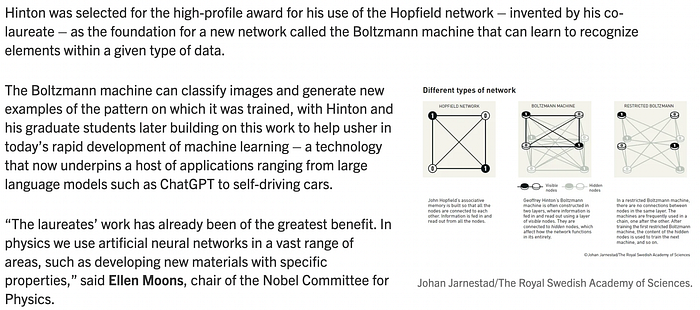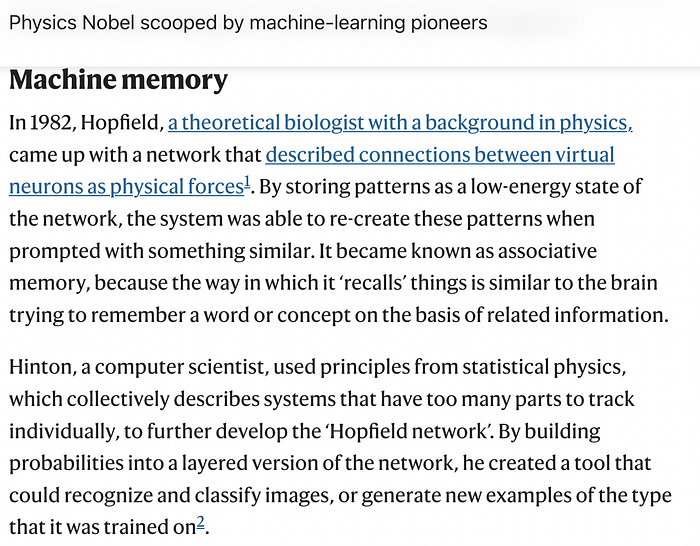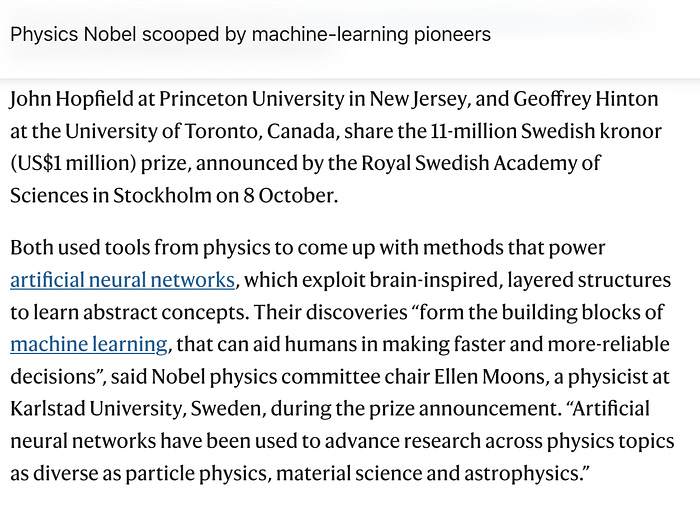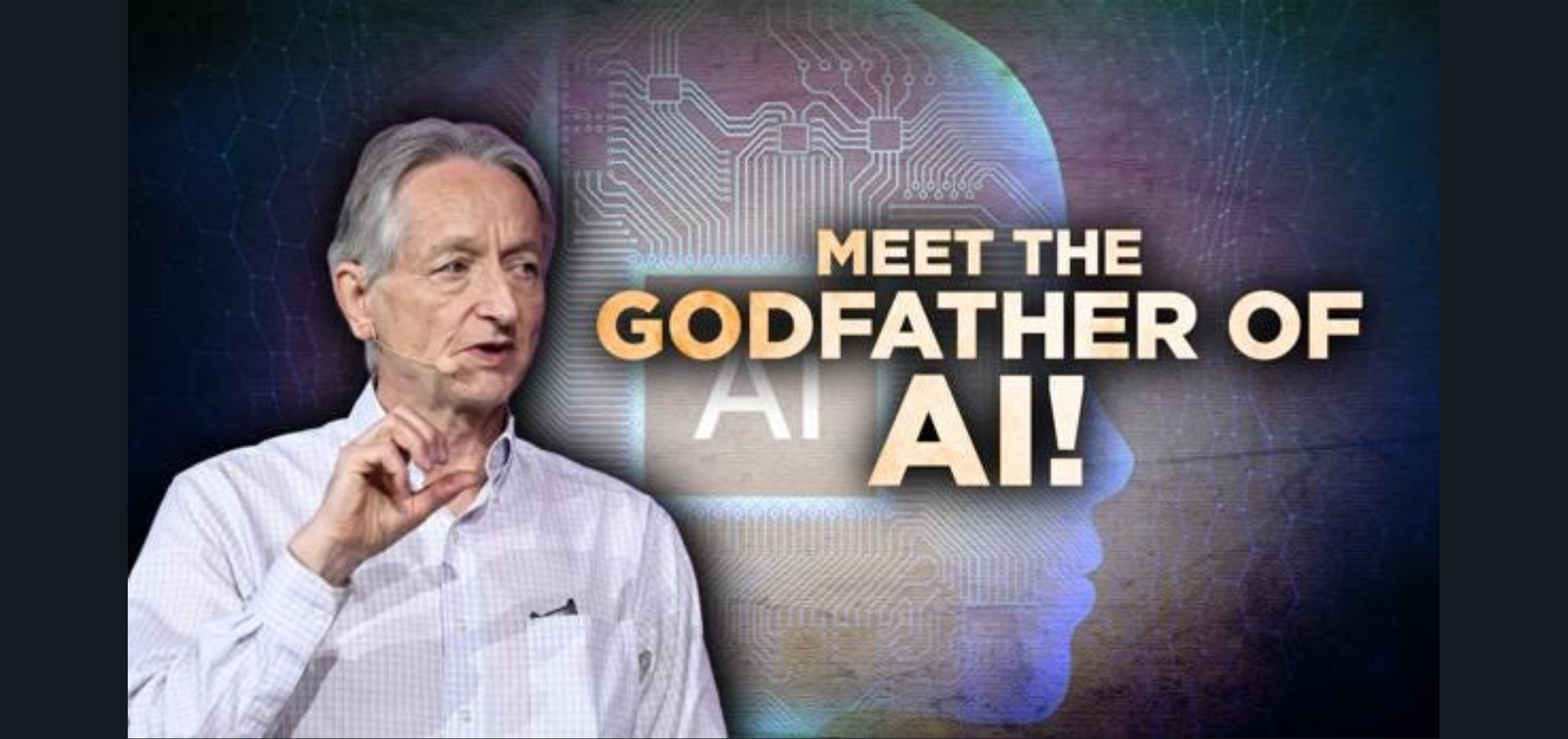Geoffrey Hinton Wins Nobel Prize
The Godfather of AI
Introduction
In a monumental moment for the world of Artificial Intelligence (AI), Geoffrey Hinton, known as the “Godfather of AI,” has been awarded the Nobel Prize for his pioneering work in neural networks and deep learning. He has been awarded the 2024 Nobel Prize in physics by the Royal Swedish Academy of Sciences. Hinton also won the A. M. Turing Award in 2018 — sometimes described as the ‘Nobel of computer science’. Hopfield, too, has won several other prestigious physics awards, including the 2001 Dirac Medal. Hinton’s contributions have reshaped AI research, influencing innovations in fields ranging from healthcare to self-driving cars. This article explores Hinton’s groundbreaking work, his journey to the Nobel Prize, and how his research has transformed the world of technology.
The Journey to the Nobel Prize
Geoffrey Hinton, born on December 6, 1947, in London, England, is a British-Canadian cognitive psychologist and computer scientist renowned for his groundbreaking work in artificial intelligence (AI). Often called the “Godfather of AI,” Hinton’s pioneering research on neural network models has fundamentally transformed the field of AI. His notable contributions, including backpropagation, Boltzmann machines, distributed representations, and time-delay neural networks, have shaped the development of modern AI systems. In 2024, Hinton was awarded the Nobel Prize in Physics, sharing the honour with American physicist John J. Hopfield.

Early Life and Intellectual Heritage
Geoffrey Hinton was born into a distinguished intellectual family. His father, Howard Everest Hinton, was a prominent entomologist, while his extended family included notable mathematicians such as George Boole, whose Boolean logic underpins modern computing, and Charles Howard Hinton, known for visualising higher dimensions. His family also includes Joan Hinton, one of the few women involved in the Manhattan Project, and George Everest, the surveyor for whom Mount Everest is named.
Academic Background
Hinton pursued his education at the University of Cambridge, initially switching between disciplines like physiology, philosophy, and physics before earning a degree in experimental psychology in 1970. He then completed a PhD in artificial intelligence at the University of Edinburgh in 1978, where he explored neural networks — unconventional systems inspired by the brain’s neural structure. Despite scepticism from his professors, Hinton’s work laid the foundation for modern neural networks, particularly in AI research.
Key Contributions to AI and Neural Networks
In 1982, Hinton joined the faculty at Carnegie Mellon University, collaborating with psychologist David Rumelhart and computer scientist Ronald J. Williams. Together, they developed the backpropagation algorithm, a method that allows neural networks to learn by working backwards from the output to adjust and reduce error. This breakthrough, published in 1986, became a cornerstone in the development of deep learning and neural network models.
Move to Canada and Ethical Stance on AI
Hinton moved to Canada in 1987, driven by his opposition to the U.S. military’s use of AI for defence purposes. He accepted a position as a professor at the University of Toronto, where he continued his research on neural networks. In 1998, Hinton founded and led the Gatsby Computational Neuroscience Unit at University College London, where he further explored the applications of neural networks.
The Rise of Deep Learning and AlexNet
Upon returning to the University of Toronto in 2001, Hinton’s research team made significant strides in deep learning technology. In 2012, he and his graduate students, Alex Krizhevsky and Ilya Sutskever, created an eight-layer neural network called AlexNet, which revolutionised image recognition by outperforming its competitors by more than 40%. This success led to the formation of DDNresearch, which was later acquired by Google for $44 million in 2013. Hinton subsequently joined Google Brain, becoming a key figure in the company’s AI research efforts.
Hinton’s contributions to AI have been widely recognised. Among his many accolades are the David E. Rumelhart Prize (2001), the Gerhard Herzberg Canada Gold Medal (2010), and the Turing Award (2018), often referred to as the “Nobel Prize of Computing.” In 2024, his impact on the field was further acknowledged with the Nobel Prize in Physics, solidifying his legacy as one of the most influential figures in the development of artificial intelligence.
Innovations Leading to Nobel Recognition
As per a report from University of Toronto, Hinton said he was “flabbergasted” at the honour as messages poured in from around the world.
“I had no expectations of this,” he told U of T News shortly after the win was announced in Stockholm Tuesday morning. “I am extremely surprised and I’m honoured to be included.”
He later told reporters at a press conference he was “in a cheap hotel in California” with no Internet and a poor phone connection when he was notified about his Nobel Prize.
“I was going to get an MRI scan today, but I think I’m going to have to cancel that.”
Below are the details of the Nobel prize as quoted by The Nobel Prize Organisation on 8th October 2024.
The Royal Swedish Academy of Sciences has decided to award the Nobel Prize in Physics 2024 to John J. Hopfield Princeton University, NJ, USA Geoffrey E. Hinton University of Toronto, Canada “for foundational discoveries and inventions that enable machine learning with artificial neural networks” “for foundational discoveries and inventions that enable machine learning with artificial neural networks”
They trained artificial neural networks using physics.
This year’s two Nobel Laureates in Physics have used tools from physics to develop methods that are the foundation of today’s powerful machine learning. John Hopfield created an associative memory that can store and reconstruct images and other types of patterns in data. Geoffrey Hinton invented a method that can autonomously find properties in data, and so perform tasks such as identifying specific elements in pictures.
When we talk about artificial intelligence, we often mean machine learning using artificial neural networks. This technology was originally inspired by the structure of the brain. In an artificial neural network, the brain’s neurons are represented by nodes that have different values. These nodes influence each other through connections that can be likened to synapses and which can be made stronger or weaker. The network is trained, for example by developing stronger connections between nodes with simultaneously high values. This year’s laureates have conducted important work with artificial neural networks from the 1980s onward.
John Hopfield invented a network that uses a method for saving and recreating patterns. We can imagine the nodes as pixels. The Hopfield network utilises physics that describes a material’s characteristics due to its atomic spin — a property that makes each atom a tiny magnet. The network as a whole is described in a manner equivalent to the energy in the spin system found in physics, and is trained by finding values for the connections between the nodes so that the saved images have low energy. When the Hopfield network is fed a distorted or incomplete image, it methodically works through the nodes and updates their values so the network’s energy falls. The network thus works stepwise to find the saved image that is most like the imperfect one it was fed with.
Geoffrey Hinton used the Hopfield network as the foundation for a new network that uses a different method: the Boltzmann machine. This can learn to recognise characteristic elements in a given type of data. Hinton used tools from statistical physics, the science of systems built from many similar components. The machine is trained by feeding it examples that are very likely to arise when the machine is run. The Boltzmann machine can be used to classify images or create new examples of the type of pattern on which it was trained. Hinton has built upon this work, helping initiate the current explosive development of machine learning.




The Significance of the Nobel Prize in the AI Community
The Nobel Prize signifies the global recognition of AI’s importance, not only in the academic realm but also in its application to industries worldwide. Hinton’s work is celebrated as a milestone for artificial intelligence, an acknowledgment of how his theories and research have paved the way for self-driving cars, voice recognition technologies, and even AI-driven medical diagnostics.
The Ethical Dilemmas Hinton Addresses in AI
While Hinton’s research has propelled AI to new heights, he has also been vocal about the ethical implications of AI. He has warned that without proper oversight, AI could become too powerful or misused, particularly in areas like surveillance, decision-making in the justice system, or autonomous weapons.
In interviews, Hinton has expressed concern about AI systems becoming uncontrollable, calling for a global conversation on AI governance to prevent potential misuse. His insights encourage researchers to prioritise transparency and safety in AI development.
As per a report from University of Toronto, Hinton likened the influence of AI to that of the Industrial Revolution during a virtual press conference with the academy earlier in the day — “But instead of exceeding people in physical strength, it’s going to exceed people in intellectual ability.”
He added that the rise of AI “is going to be wonderful in many respects,” citing health care and workplace productivity as two areas poised to benefit hugely from the technology. “But we also have to worry about a number of possible bad consequences, particularly the threat of these things getting out of control,” Hinton said.
In early 2023, Hinton quit his job at Google and focused on sounding the alarm about the risks of rapid and unfettered AI development.
As per an article from Nature as well, in recent years, Hinton has become one of the loudest voices calling for safeguards to be placed around AI. He says he became convinced last year that digital computation had become better than the human brain, thanks to its ability to share learning from multiple copies of an algorithm, running in parallel. “It made me think [that these systems are] going to become more intelligent than us sooner than I thought,” he said on 31 May, speaking virtually to the AI for Good Global Summit in Geneva, Switzerland. “Up until that point, I’d spent 50 years thinking that if we could only make it more like the brain, it will be better.”
Here is an interesting video from Youtube CBC News, showing details of British Canadian Geoffrey Hinton Nobel Prize for AI discoveries.
Conclusion
Geoffrey Hinton’s Nobel Prize win in 2024 is a landmark recognition of the transformative impact of his research on artificial intelligence, particularly neural networks and deep learning. His pioneering work, which spans several decades, has laid the groundwork for modern AI technologies that are reshaping industries globally. From healthcare innovations to autonomous vehicles, Hinton’s discoveries have revolutionised our interaction with technology. His advocacy for ethical AI development is equally significant, reminding us of the critical need for thoughtful governance as AI systems continue to evolve. As AI reaches new heights, Hinton’s contributions remain central to its trajectory, both in terms of technical advancement and moral responsibility.
References
[1] CBC News, “Geoffrey Hinton Wins Nobel Prize for AI Discoveries,” YouTube, 2024. [Online]. Available: https://www.youtube.com/watch?v=_S-IOXNegFw.
[2] D. Castelvecchi, “Geoffrey Hinton Wins Nobel for AI Discoveries,” Nature, vol. 624, 2024. [Online]. Available: https://www.nature.com/articles/d41586-024-03213-8.
[3] The Nobel Prize, “The Nobel Prize in Physics 2024,” The Nobel Prize, 8-Oct-2024. [Online]. Available: https://www.nobelprize.org/prizes/physics/2024/press-release/.
[4] University of Toronto, “Geoffrey Hinton Wins Nobel Prize,” U of T News, 2024. [Online]. Available: https://defygravitycampaign.utoronto.ca/news-and-stories/geoffrey-hinton-nobel-prize/.
Catch the latest version of this article over on Medium.com. Hit the button below to join our readers there.



















